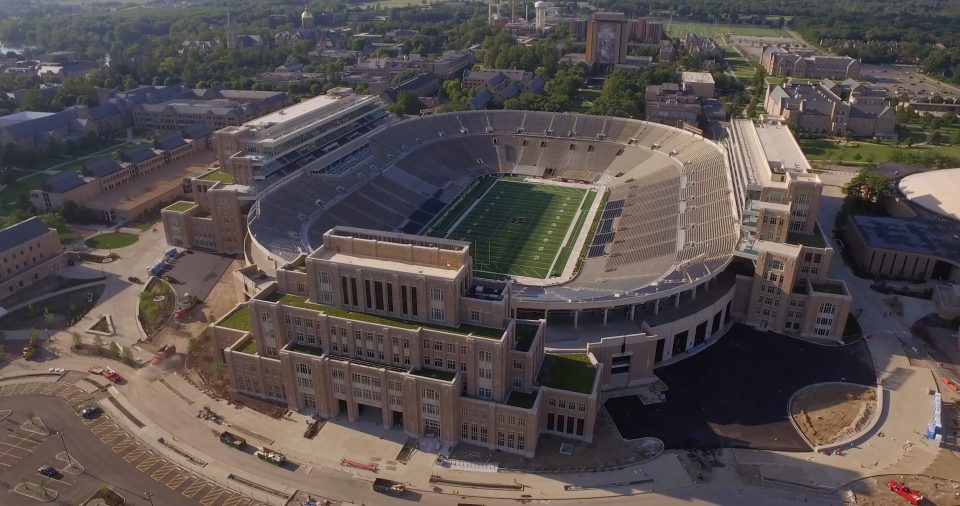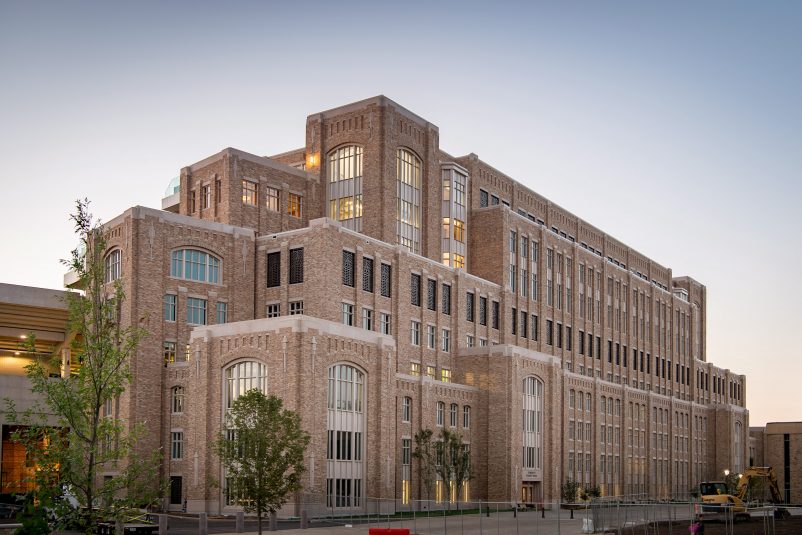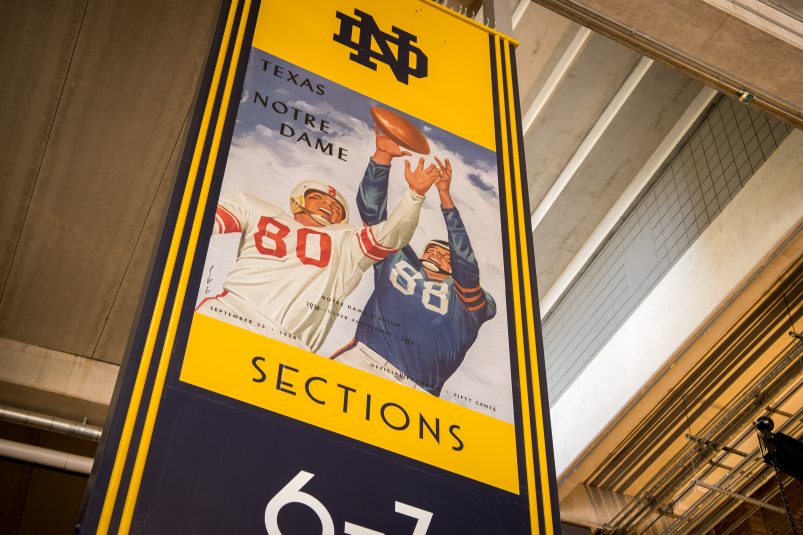New Era at Notre Dame: Campus Crossroads Redefines College Video
New Rex and Alice A. Martin Media Center will support the university’s video and multimedia efforts
Story Highlights
Since the days of Knute Rockne and “The Gipper,” the University of Notre Dame has forged a football program steeped in history, tradition, and victory. Over nearly a century, the school has continually leveraged the overwhelming success of its athletic program to benefit its academic and faith-based missions. That tradition continues with the Campus Crossroads Project, the university’s most ambitious building campaign in its 175-year history.

Completion of the Campus Crossroads Project has transformed Notre Dame Stadium into a year-round center of student activity.
At the heart of the Campus Crossroads Project is Notre Dame Stadium, an iconic venue fully used only a handful of times per year. The project changed that by adding a structure to the west, east, and south sides of the stadium, transforming it into a year-round center of student activity.
On the west side, the Duncan Student Center houses a student sports and recreation center as well as a wide variety of student lounges, offices, and retail dining options. On the south, O’Neill Hall welcomes the Department of Music and the Sacred Music at Notre Dame program.
The pièce de résistance, however, has taken shape on the east side of Notre Dame Stadium: Corbett Family Hall houses the new 18,000-sq.-ft Rex and Alice A. Martin Media Center, which supports all university video-content- and multimedia-creation efforts. From digital content in support of academics and faith-based initiatives to production of videoboard shows in Notre Dame Stadium, Purcell Pavilion, and Compton Family Ice Arena, it will be a resource for students, faculty, and staff.
“There’s a quote sitting right outside my door that I look at every day, all day, and it says one of Notre Dame’s greatest assets has been the boldness of its vision, the ability to see possibilities and connections where others saw only obstacles and fragmentation,” says University of Notre Dame Director, Broadcast Technology, Scott Rinehart, referring to a statement by university President Rev. John I. Jenkins CSC. “I look at that, and it hits me everyday that this place is willing to accept calculated risk. It’s what it does; it’s in the DNA of the university system to do that. And, luckily, we had essentially a greenfield possibility here to do that.”
The Rex and Alice A. Martin Media Center is home to Fighting Irish Media — the video-production, storytelling, and communications arm of Notre Dame’s athletics department — as well as to the university’s Marketing Communications Video Group, Office of Digital Learning, and Catholic Media. Providing the underlying support and operation of the Martin Media Center for the resident stakeholders is Notre Dame Studios, which will also support a wide variety of campus customers: university relations, student affairs, and many more.
For more on Fighting Irish Media’s approach to video production at Notre Dame Stadium, CLICK HERE.
“The scope of ND Studios [is not just] building cameras and control rooms and routing systems to support a videoboard show with football,” Rinehart explains. “It’s not like a pro venue, where that’s the only thing that control room does. We had to think of control rooms that support performing-arts performances, lecture capture, and overseas research. And, as people start getting exposed to this facility, they see the technology and [say], I need to do XYZ, can you help me? Those conversations are starting to percolate now.”
Entering the Rex and Alice A. Martin Media Center, visitors are greeted by a 1.8-mm-pixel-pitch video wall that displays content from across the university. The 1,700-sq.-ft. main studio is located in the northeast corner of the building, next to two control rooms, two dual-purpose audio rooms, and a green room. (Additionally, the existing facilities in the Fighting Irish Media Center, located in the Joyce Center, have been integrated into the Martin Media Center workflow and are now available for campus use.)
The control rooms, integrated by BeckTV, feature a Ross Video Acuity switcher and XPression graphics, Evertz EXE 23T router and DreamCatcher replay servers, Axia Fusion audio consoles, and Riedel Artist intercoms. All workstations will be connected via a fiber KVM system for added flexibility. In addition, the team will have Grass Valley cameras with Canon lenses.
The south end of the building comprises a teaching studio, an academic-innovation space, six edit rooms, and open office space for the four resident stakeholders. To fulfill the demands of Notre Dame Studios, the university hired three full-time engineers, a media-asset manager, and a production manager and transitioned five academic digital-media positions to it.
Throughout the construction of the Martin Media Center, a heavy emphasis has been placed on collaboration among the departments and on considering the needs of the athletic department as integral to — not separate from or more important than — the overall university mission.
“As an athletic department, it’s important to reach out and work with the academic departments or communication department,” says Dan Skendzel, executive director, Notre Dame Studios. “You fulfill that by making production space available or building a student program with them so that everyone wins. Most important, students [win]: it puts the academic aspect of their offering into real-life scenarios as well.”
The central equipment room, which comprises around 25 racks and is based almost exclusively on fiber (with some coax, as needed), is also located in the south end of the facility.
The university, looking to the future of broadcast technology, decided early in the process to pursue an IP infrastructure and relied heavily on BeckTV, as well as on consultant WJHW, for design and installation of the IP production technology. Together, the group selected an Evertz EXE 23T router and Axia Audio with AES67 AoIP networking technology.
“There were some difficult conversations,” Rinehart explains. “Do you go safe with baseband, or are we at enough of the tipping point on IP video that we could invest in that for the future? I looked at where manufacturers were spending their R&D dollars, and it’s IP. It felt like there was this huge race to go IP.
“Once you start getting into it and you start trying to understand what’s possible with it,” he continues, “for a place like Notre Dame, it’s a great fit. Because we want to make Notre Dame Studios not just four walls within this one building and not just the edges of the South Bend campus. We want to take it global.”
SVG’s Ken Kerschbaumer contributed to this article.


